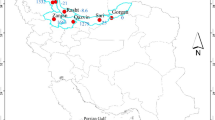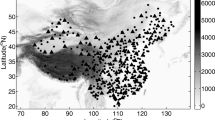Abstract
As a common and extensive datum to analyze wind, wind rose is one of the most important components of the meteorological elements. In this study, a model is proposed to establish the joint probability distribution of wind speed and direction using grouped data of wind rose. On the basis of the model, an algorithm is presented to generate pseudorandom numbers of wind speed and paired direction data. Afterward, the proposed model and algorithm are applied to two weather stations located in the Liaodong Gulf. With the models built for the two cases, a novel graph representing the continuous joint probability distribution of wind speed and direction is plotted, showing a strong correlation to the corresponding wind rose. Moreover, the joint probability distributions are utilized to evaluate wind energy potential successfully. In cooperation with Monte Carlo simulation, the model can approximately predict annual directional extreme wind speed under different return periods under the condition that the wind rose can represent the meteorological characters of the wind field well. The model is beneficial to design and install wind turbines.
Similar content being viewed by others
References
Adaramola, M. S., Paul, S. S., and Oyedepo, S. O., 2011. Assessment of electricity generation and energy cost of wind energy conversion systems in north-central Nigeria. Energy Conversion and Management, 52(12): 3363–3368.
Akaike, H., 1998. Information theory and an extension of the maximum likelihood principle. In: Selected Papers of Hirotugu Akaike. Parzen, E., et al., eds., Springer Series in Statistics, Springer, New York, 199–213.
Akdağ, S. A., Bagiorgas, H. S., and Mihalakakou, G., 2010. Use of two-component Weibull mixtures in the analysis of wind speed in the eastern Mediterranean. Applied Energy, 87: 2566–2573.
Allouhi, A., Zamzoum, O., Islam, M. R., Saidur, R., Kousksou, T., Jamil, A., et al., 2017. Evaluation of wind energy potential in Morocco’s coastal regions. Renewable and Sustainable Energy Reviews, 72: 311–324.
Alsaad, M. A., 2013. Wind energy potential in selected areas in Jordan. Energy Conversion and Management, 65: 704–708.
Cambou, M., Hofert, M., and Lemieux, C., 2015. Quasi-random numbers for copula models. Statistics & Computing, 27: 1–23.
Carta, J. A., and Ramírez, P., 2007a. Analysis of two-component mixture Weibull statistics for estimation of wind speed distributions. Renewable Energy, 32: 518–531.
Carta, J. A., and Ramírez, P., 2007b. Use of finite mixture distribution models in the analysis of wind energy in the Canarian Archipelago. Energy Conversion and Management, 48: 281–291.
Carta, J. A., Bueno, C., and Ramírez, P., 2008a. Statistical modelling of directional wind speeds using mixtures of von Mises distributions: Case study. Energy Conversion and Management, 49: 897–907.
Carta, J. A., Ramírez, P., and Bueno, C., 2008b. A joint probability density function of wind speed and direction for wind energy analysis. Energy Conversion and Management, 49: 1309–1320.
Carta, J. A., Ramírez, P., and Velázquez, S., 2009. A review of wind speed probability distributions used in wind energy analysis: Case studies in the Canary Islands. Renewable and Sustainable Energy Reviews, 13: 933–955.
Cohen, A. C., 1950. On estimation the mean and variance of singly truncated normal frequency distributions from the first three samples moments. Annals of the Institute of Statistical Mathematics, 3: 37–44.
Cook, N. J., 2019. The OEN mixture model for the joint distribution of wind speed and direction: A globally applicable model with physical justification. Energy Conversion and Management, 191: 141–158.
Erdem, E., and Shi, J., 2011. Comparison of bivariate distribution construction approaches for analyzing wind speed and direction data. Wind Energy, 14: 27–41.
Erdem, E., Li, G., and Shi, J., 2010. Comprehensive evaluation of wind speed distribution models: A case study for North Dakota sites. Energy Conversion and Management, 51(7): 1449–1458.
Feng, J., and Shen, W. Z., 2015. Modelling wind for wind farm layout optimization using joint distribution of wind speed and wind direction. Energies, 8: 3075–3092.
Han, Q. K., Hao, Z. L., Hu, T., and Chu, F. L., 2018. Non-parametric models for joint probabilistic distributions of wind speed and direction data. Renewable Energy, 126: 1032–1042.
Han, Q. K., Ma, S., Wang, T. Y., and Chu, F. L., 2019. Kernel density estimation model for wind speed probability distribution with applicability to wind energy assessment in China. Renewable and Sustainable Energy Reviews, 115: 109387.
Huang, S., and Wan, H., 2012. Determination of suitability between wind turbine generators and sites including power density and capacity factor considerations. IEEE Transactions on Sustainable Energy, 3(3): 390–397.
Jaramillo, O. A., and Borja, M. A., 2004. Bimodal versus Weibull wind speed distributions: An analysis of wind energy potential in La Venta, Mexico. Wind Engineering, 28(2): 225–234.
Johnson, R. A., and Wehrly, T. E., 1978. Some angular-linear distributions and related regression models. Journal of the American Statistical Association, 73(363): 602–606.
Justus, C. G., Hargraves, W. R., Mikhail, A., and Graber, D., 1978. Methods for estimating wind speed frequency distributions. Journal of Applied Meteorology, 17(3): 350–353.
Kantar, Y. M., and Usta, I., 2015. Analysis of the upper-truncated Weibull distribution for wind speed. Energy Conversion and Management, 96: 81–88.
Keyhani, A., Ghasemi-Varnamkhasti, M., Khanali, M., and Abbaszadeh, R., 2010. An assessment of wind energy potential as a power generation source in the capital of Iran, Tehran. Energy, 35: 188–201.
Koeppl, G. W., 1982. Putnam’s Power from the Wind. 2nd edition. Van Nostrand Reinhold, New York, 67–89.
Laio, F., 2004. Carmer-von Mises and Anderson-Darling goodness of fit tests for extreme value distributions with unknown parameters. Water Resource Research, 40: W09308.
Li, H. N., Zheng, X. W., and Li, C., 2019. Copula-based joint distribution analysis of wind speed and direction. Journal of Engineering Mechanics, 145(5): 04019024.
Li, Z. Q., Chen, S. J., Ma, H., and Feng, T., 2013. Design defect of wind turbine operating in typhoon activity zone. Engineering Failure Analysis, 27: 165–172.
Liu, F., Sun, F. B., Liu, W. B., Wang, T. T., Wang, H., Wang, X. M., et al., 2019. On wind speed pattern and energy potential in China. Applied Energy, 236: 867–876.
Madsen, K., Nielsen, H. B., and Tingleff, O., 2004. Methods for Non-Linear Least Squares Problems. Technical University of Denmark, Denmark, 1–49.
Masseran, N., Razali, A. M., and Ibrahim, K., 2012. An analysis of wind power density derived from several wind speed density functions: The regional assessment on wind power in Malaysia. Renewable and Sustainable Energy Review, 16: 6476–6487.
Masseran, N., Razali, A. M., Ibrahim, K., and Latif, M. T., 2013. Fitting a mixture of von Mises distributions in order to model data on wind direction in Peninsular Malaysia. Energy Conversion and Management, 72: 94–102.
Mazzeo, D., Oliveti, G., and Labonia, E., 2018. Estimation of wind speed probability density function using a mixture of two truncated normal distributions. Renewable Energy, 115: 1260–1280.
McWilliams, B., and Sprevak, D., 1980. The estimation of the parameters of the distribution of wind speed and direction. Wind Engineering, 4: 227–238.
McWilliams, B., Newmann, M. M., and Sprevak, D., 1979. The probability distribution of wind velocity and direction. Wind Engineering, 3: 269–273.
Mirhosseini, M., Sharifi, F., and Sedaghat, A., 2011. Assessing the wind energy potential locations in province of Semnan in Iran. Renewable and Sustainable Energy Reviews, 15: 449–459.
Mohammadi, K., Alavi, O., Mostafaeipour, A., Goudarzi, N., and Jalilvan, M., 2016. Assessing different parameters estimation methods of Weibull distribution to compute wind power density. Energy Conversion and Management, 108: 322–335.
Ovgor, B., Lee, S., and Lee, S., 2012. A method of micrositing of wind turbine on building roof-top by using joint distribution of wind speed and direction, and computational fluid dynamics. Journal of Mechanical Science and Technology, 26(12): 3981–3988.
Pishgar-Komleh, S. H., Keyhani, A., and Sefeedpari, P., 2015. Wind speed and power density analysis based on Weibull and Rayleigh distributions (a case study: Firouzkooh county of Iran). Renewable and Sustainable Energy Reviews, 42: 313–322.
Qin, X., Zhang, J. S., and Yan, X. D., 2010. A new circular distribution and its application to wind data. Journal of Mathematics Research, 2(3): 12.
Schindler, D., and Jung, C., 2018. Copula-based estimation of directional wind energy yield: A case study from Germany. Energy Conversion and Management, 169: 359–370.
Stephen, B., Galloway, S., McMillan, D., Anderson, L., and Ault, G., 2013. Statistical profiling of site wind resource speed and directional characteristics. IET Renewable Power Generation, 7(6): 583–592.
Tiang, T. L., and Ishak, D., 2012. Technical review of wind energy potential as small-scale power generation sources in Penang Island Malaysia. Renewable and Sustainable Energy Reviews, 16: 3034–3042.
Vanem, E., Hafver, A., and Nalvarte, G., 2020. Environmental contours for circular-linear variables based on the direct sampling method. Wind Energy, 23: 563–574.
Wang, J. Z., Hu, J. M., and Ma, K. L., 2016. Wind speed probability distribution estimation and wind energy assessment. Renewable and Sustainable Energy Reviews, 60: 881–899.
Wang, J. Z., Qin, S. S., Jin, S. Q., and Wu, J., 2015. Estimation methods review and analysis of offshore extreme wind speeds and wind energy resources. Renewable and Sustainable Energy Reviews, 42: 26–42.
Weber, R., 1991. Estimator for the standard deviation of wind direction based on moments of the Cartesian components. Journal of Applied Meteorology, 30(9): 1341–1353.
Weber, R., 1997. Estimators for the standard deviation of horizontal wind direction. Journal of Applied Meteorology, 36: 1407–1415.
Ye, X. W., Xi, P. S., and Nagode, M., 2019. Extension of REBMIX algorithm to von Mises parametric family for modeling joint distribution of wind speed and direction. Engineering Structures, 183: 1134–1145.
Yuan, L., and Kalbfleisch, J. D., 2000. On the Bessel distribution and related problems. Annals of the Institute of Statistical Mathematics, 52(3): 438–447.
Zhang, J., Chowdhury, S., Messac, A., and Castillo, L., 2013. A multivariate and multimodal wind distribution model. Renewable Energy, 51: 436–477.
Acknowledgements
The study was supported by the National Key Research and Development Program of China (No. 2016YFC03034 01), the National Natural Science Foundation of China (No. 51779236), and the National Natural Science Foundation of China — Shandong Joint Fund (No. U1706226).
Author information
Authors and Affiliations
Corresponding author
Rights and permissions
About this article
Cite this article
Yang, Z., Lin, Y. & Dong, S. Joint Model of Wind Speed and Corresponding Direction Based on Wind Rose for Wind Energy Exploitation. J. Ocean Univ. China 21, 876–892 (2022). https://doi.org/10.1007/s11802-022-4860-2
Received:
Revised:
Accepted:
Published:
Issue Date:
DOI: https://doi.org/10.1007/s11802-022-4860-2




